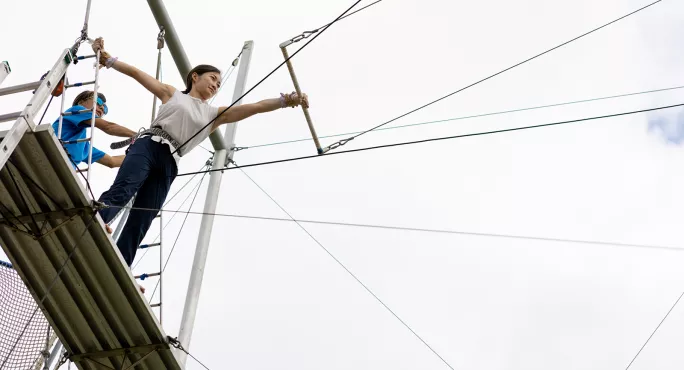- Home
- Teaching & Learning
- General
- 5 tips for supporting primary-secondary transition
5 tips for supporting primary-secondary transition

English football player Jordan Henderson’s ill-fated jaunt to the Saudi Pro League received much media coverage. The move - despite personal assistants, translators, imported food choices, accompanying family and vastly lucrative financial incentives - was cut short.
In the end, Henderson left within six months, incurring substantial tax implications and a significant loss of income. Reflecting on his decision, Henderson cited the challenge of the intense heat in Saudi Arabia and his difficulty in adjusting to a new environment.
Considering the magnitude of change, it is, to be fair, understandable: new culture, language, environment, peers and lifestyle changes all coming at once would be a challenge for anyone.
In many ways, the experience of a P7 pupil journeying towards a brand new secondary school is not dissimilar to Henderson’s story - the destination might not be as exotic, but the stakes, importance and challenges are as high.
Many children experience difficulties with transition: a study found that one in four find it difficult. Between 2008 and 2018, more than 80 per cent of the 96 research articles on primary-secondary school transitions highlighted the challenges associated with these transitions, noting a negative influence on academic outcomes.
Increasing pressure on teachers’ time and resources means it’s crucial that we allocate these effectively to prepare our pupils.
By providing them with an understanding of what they may encounter and empowering them to overcome challenges, all while fostering collaboration between parents and teachers, we can support positive outcomes.
Here are our tips on how to do this:
1. Build transition in, not on
Early preparation from primary school is essential. While primary school teachers primarily deliver this, secondary schools must offer accurate information to assist in the process.
- Related: How ‘transition teachers’ can bridge the divide
- Transition teachers: Supporting the secondary school leap of faith
- Analysis: Are we getting lost in transition?
Whenever feasible, inviting primary staff into secondary schools provides them with first-hand experiences to better inform their pupils. Establishing strong relationships with feeder schools fosters trust and promotes continuity.
2. Re-establish learner competencies
The academic shift from primary to secondary can be unsettling for pupils and it is normal for attainment to take a dip in the initial stages of S1.
To counteract this impact, organising visits by secondary teachers to primary schools to deliver lessons and allowing pupils to experience class set-ups and expectations before and during transition days.
One significant challenge for young people is the notable shift in curriculum language. Introducing bridging units, which are taught both in primary school and during the first term of secondary school, can aid in re-establishing competencies and building confidence.
3. Practical planning is key
Many professional athletes discuss the positive impact of visualisation before their events. Providing young people with the details and experiences of where they are going will help them mentally prepare and visualise themselves in the role of an S1.
It is important that pupils can become familiar not only with the internal layout of the school but also with the route to school.
Getting lost is never fun and can add to feelings of hesitation and worry. As early as possible, schools should facilitate the opportunity for pupils to familiarise themselves with the layout of the school.
This could include orienteering settling in events, specific transition trails or the production of maps and or video clips. These can be excellent for team building and help pupils build confidence, as well as reduce anxiety in their new surroundings.
4. Support social interactions
As young people move toward their mid-teen years, social interactions become one of the most important factors impacting their school happiness.
Over and above transition days, schools should facilitate co-curricular clubs for P7 that mirror those offered in S1. This will help create instant familiarity and support young people at a time when almost everything else has changed.
School events such as sports days and residential trips organised among feeder schools can be hugely impactful, too.
Enabling structured time and support where team building and social relationships are priorities is key to enabling pupils to mix comfortably before starting S1 transition groups, team building and other connections.
5. Connect with parents and carers early
Where possible, initiate early engagement with parents and carers through open days and information sessions.
Parents themselves may have their own worries and anxieties about transition. Involving them early in positive preparation activities provides an opportunity to explore and dispel these concerns, and will minimise the chances of these tensions impacting their young person.
Introduce key staff from secondary school to P7 pupils and their families and, if possible, facilitate regular check-ins with guidance staff.
Clearly communicate expectations and codes of conduct, and normalise concerns - it’s OK to be apprehensive. Signpost access to support and information to help soothe these worries.
By involving families from the beginning, openly addressing concerns and providing continuous support, schools can ensure that both students and their families feel prepared and supported throughout the transition process - and, critically, know where to access help if necessary.
Kirsten Colquhoun is a head of guidance and senior school teacher and Jane Tulloch is head of primary, both at Robert Gordon’s College, an all-through independent school in Aberdeen
For the latest Scottish education news, analysis and features delivered directly to your inbox, sign up to Tes magazine’s The Week in Scotland newsletter
You need a Tes subscription to read this article
Subscribe now to read this article and get other subscriber-only content:
- Unlimited access to all Tes magazine content
- Exclusive subscriber-only stories
- Award-winning email newsletters
Already a subscriber? Log in
You need a subscription to read this article
Subscribe now to read this article and get other subscriber-only content, including:
- Unlimited access to all Tes magazine content
- Exclusive subscriber-only stories
- Award-winning email newsletters



